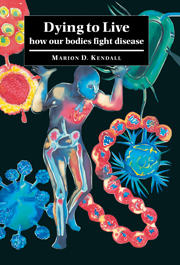5 - The Fight Begins
Published online by Cambridge University Press: 29 September 2009
Summary
Meningitis There are several forms of meningitis, caused by viruses and bacteria, all of which result in acute or chronic inflammation of the membranes over the brain. This covering is called the meninges, hence meningitis means inflammation of this region. Many viruses causing common diseases such as mumps and polio, and the enteroviruses can, after infecting the rest of the body, enter the meninges of the brain. Viral meningitis is often slower to develop than bacterial meningitis and is generally milder. Bacterial meningitis is not so common, but is often a much more serious disease which can kill in a short period of time. It may start as an upper respiratory tract infection, fever and a rash, and can be passed on by coughing and sneezing. Once in the body the causative agents pass to the brain via the blood. If the meningitis is caused by Neisseria meningitidis (meningococcus) the rash that may occur on the limbs is purplish. This used to be known as spotted fever. Streptococcus pneumoniae (pneumococcus) is another infective agent, and in babies it is often Escherichia coli or Listeria monocytogenes that causes meningitis. In the west of America, in California, Arizona, Texas and Mexico, meningitis can be caused by a fungus, Coccidioides immitis. This fungus is very common in the soil and as many as 90% of the population may show evidence of having been infected previously. In severe infections, this form of meningitis may become a killer.
- Type
- Chapter
- Information
- Dying to LiveHow our Bodies Fight Disease, pp. 73 - 92Publisher: Cambridge University PressPrint publication year: 1998



